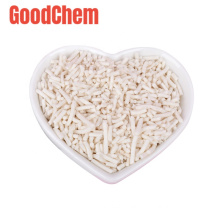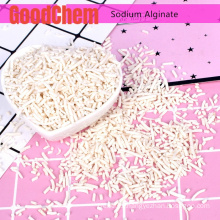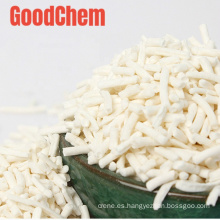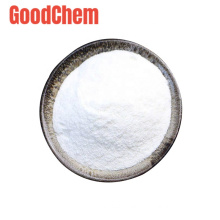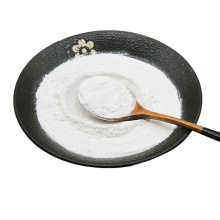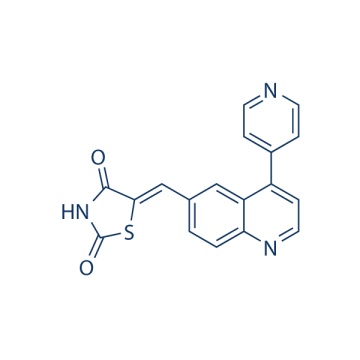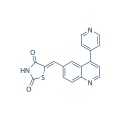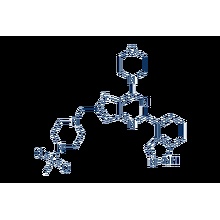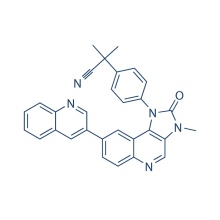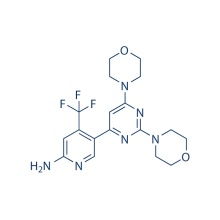.cp_wz tabla {borde superior: 1px sólido #ccc; borde izquierdo: 1px sólido #ccc; } .cp_wz table td {borde derecho: 1px sólido #ccc; borde inferior: 1px sólido #ccc; padding: 5px 0px 0px 5px;} .cp_wz table th {border-right: 1px solid #ccc; border-bottom: 1px solid #ccc; relleno: 5px 0px 0px 5px;} \ n Peso molecular: 333.36 GSK1059615 es un inhibidor dual de PI3Kα / β / δ / γ (reversible) y mTOR con IC50 de 0.4 nM / 0.6 nM / 2 nM / 5 nM y 12 nM, respectivamente. Fase 1. \ n El derivado de piridinilquinolina GSK1059615 es un inhibidor nuevo, competitivo con ATP y reversible de la familia de PI3K de clase I. GSK1059615 inhibe la señalización de PI3K, induce la detención y apoptosis de G1, especialmente en las células tumorales de mama. Los datos resumidos en otra revisión también muestran que GSK1059615 inhibe PI3Kα, β, γ y δ, con Ki de 0,42 nM, 0,6 nM, 0,47 nM y 1,7 nM, respectivamente. Otro informe muestra que GSK1059615 inhibe PI3Kα con IC50 de 2 nM. En las células cancerosas T47D y BT474, GSK1059615 inhibe la fosforilación de Akt en S473, con IC50 de 40 nM. En modelos de ratones de xenoinjerto de células de cáncer de mama BT474 o HCC1954, GSK1059615 (25 mg / kg) inhibe eficazmente el crecimiento tumoral. Un inhibidor nuevo, competitivo con ATP y reversible de PI3Kα, β, δ y γ, y mTOR. \ n Protocolo (solo como referencia) Ensayo de quinasa: [4]
|
HTRF In vitro Profiling Assays for PI3K Inhibition
|
The measurement of the GSK1059615-dependent inhibition of the PI3Ks is accessed using a HTRF based PI3K profiling assay kit. 400 pM enzyme is used in PI3Kα and δ assays, 200 pM in PI3Kβ assays, and 1 nM in PI3Kγ assay. In addition, the PI3Kα, β, and δ assays are run with 150 mM NaCl and 100 μM ATP, while the PI3Kγ assay is run with no NaCl and 15 μM ATP. All reactions are run at 10 μM PIP2. GSK1059615 is serially diluted (3-fold in DMSO), and 50 nL is transferred to a 384-well low-volume assay plate. PI3K Reaction Buffer is prepared by diluting the stock 1:4 with de-ionized water. Freshly prepared DTT is added at a final concentration of 5 mM on the day of use. Enzyme addition and GSK1059615 pre-incubation are initiated by the addition of 2.5 µL of PI3K in reaction buffer. Plates are incubated at room temperature for 15 min. Reactions are initiated by addition of 2.5 µL of 2× substrate solution (PIP2 and ATP in 1× reaction buffer). Plates are incubated at room temperature for one hour. Reactions are quenched by the addition of 2.5 µL of stop solution. The quenched reactions are then processed to detect product formation by adding 2.5 µL of Detection Solution. Following a 1-hour incubation in the dark, the HTRF signal is measured on the Envision plate reader set for 330nm excitation and dual emission detection at 620nm (Eu) and 665nm (APC). The IC50 value is then obtained.
|
Ensayo celular: [4]
|
Cell lines
|
T47D and BT474 cells
|
|
Concentrations
|
0–1 μM, serially diluted (3-fold) in DMSO
|
|
Incubation Time
|
30 min
|
|
Method
|
Cells are plate at a density of 1 × 104 cells per well in clear flat-bottomed 96-well plates and incubated overnight. Then, GSK1059615 is added and the plates are incubated for 30 min. At the end of incubation, media is aspirated from the plates, and the plate is wash once with cold PBS. 80 μL MSD Lysis buffer is added into each well and the plates are incubated on a shaker at 4 °C for at least 30 min. For Akt duplex assay, plates are washed with 200 μL/well wash buffer for 4 times and tapped on paper towel to blot. Then, 60 μL lysates is added to each well and the plates are incubated on shaker at room temperature for 1 hour. After another 4 times washing, antibody is added (25 μL per well) and the plates are incubated on shaker for 1 hour and washed again. Finally, Read Buffer is added (150 μL per well) and the plates are read immediately. IC50 values are then obtained.
|
Estudio con animales: [3]
|
Animal Models
|
Xenograft mice models of BT474 or HCC1954 cells
|
|
Formulation
|
|
|
Dosages
|
25 mg/kg
|
|
Administration
|
Oral gavage
|
Conversión de diferentes modelos de animales basados en BSA (valor basado en datos del Borrador de Directrices de la FDA)
|
Species
|
Baboon
|
Dog
|
Monkey
|
Rabbit
|
Guinea pig
|
Rat
|
Hamster
|
Mouse
|
|
Weight (kg)
|
12
|
10
|
3
|
1.8
|
0.4
|
0.15
|
0.08
|
0.02
|
|
Body Surface Area (m2)
|
0.6
|
0.5
|
0.24
|
0.15
|
0.05
|
0.025
|
0.02
|
0.007
|
|
Km factor
|
20
|
20
|
12
|
12
|
8
|
6
|
5
|
3
|
|
Animal A (mg/kg) = Animal B (mg/kg) multiplied by
|
Animal B Km
|
|
Animal A Km
|
Por ejemplo, para modificar la dosis de resveratrol utilizada para un ratón (22,4 mg / kg) a una dosis basada en el BSA para una rata, multiplique 22,4 mg / kg por el factor Km para un ratón y luego divida por el factor Km para una rata. Este cálculo da como resultado una dosis equivalente para ratas de resveratrol de 11,2 mg / kg.
|
Rat dose (mg/kg) = mouse dose (22.4 mg/kg) ×
|
mouse Km(3)
|
= 11.2 mg/kg
|
|
rat Km(6)
|
Información química
|
Molecular Weight (MW)
|
333.36
|
|
Formula
|
C18H11N3O2S
|
|
CAS No.
|
958852-01-2
|
|
Storage
|
3 years -20℃Powder
|
|
6 months-80℃in solvent (DMSO, water, etc.)
|
|
Synonyms
|
|
|
Solubility (25°C) *
|
In vitro
|
DMSO
|
2 mg/mL
(5.99 mM)
|
|
Water
|
<1 mg/mL
(
|
|
Ethanol
|
<1 mg/mL
(
|
* <1 mg/ml means slightly soluble or insoluble.
* Please note that Selleck tests the solubility of all compounds in-house, and the actual solubility may differ slightly from published values. This is normal and is due to slight batch-to-batch variations.
|
|
Chemical Name
|
(Z)-5-((4-(pyridin-4-yl)quinolin-6-yl)methylene)thiazolidine-2,4-dione
|
Calculadora de molaridad Calculadora de dilución Calculadora de peso molecular
Grupos de Producto : PI3K / Akt / mTOR > Inhibidor de PI3K
